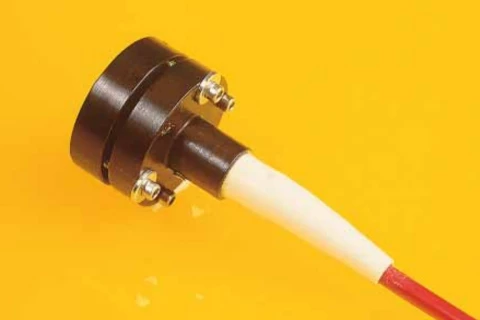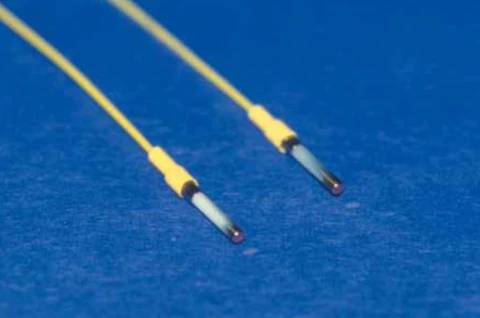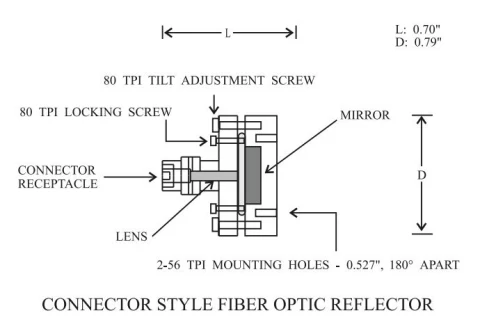Description
The Fiber Optic Reflectors are versatile components used in fiber optic systems for reflecting light back into the reverse direction. They are commonly employed in interferometric sensors, circulators, return loss testing, and reference beam power measurements.
These reflectors feature a wide range of available wavelengths, low insertion loss, compact housing, and are available in single-mode, polarization maintaining, and multimode versions.
Fiber Optic Reflectors
Specifications
| Center Wavelength: | 400 nm |
|---|---|
| Operating Wavelength Range: | 400 – 1600 nm |
| Typical Insertion Loss: | 0.6 dB |
| Max Insertion Loss: | Not Specified |
| Min Extinction Ratio: | Not Specified |
| Max Optical Power: | Not Specified |
| Broadband Reflectors: | Achromatic lenses for collimating light at different wavelengths |
| Mirror Adjustment: | OZ Optics' patented tilt adjustment technique |
| Fiber Length: | Customizable (in meters) |
| Pigtail Style Reflectors: | Fiber permanently attached to collimating lens |
| Connector Style Reflectors: | Connector receptacle style with female connector receptacle for easy changes |
| Reflectance Level (Total): | Dependent on mirror coating material (e.g., gold-coated for infrared) |
| Reflectivity Level (Partial): | Adjustable via blocking screw |
| Reflectivity: | Total reflecting or partial reflecting |
| Housing: | Compact |
| Fiber Types: | Single-mode, polarization maintaining, multimode |
| Insertion Loss: | Low |
Features
- Wide range of available wavelengths
- Available in single-mode, polarization maintaining, and multimode versions
- Low insertion loss
- Compact housing
- Partial reflectors available
Applications
- Interferometric sensors
- Circulators
- Return loss testing
- Reference beam power measurements
Frequently Asked Questions
What are Fiber Optic Reflectors used for?
Fiber Optic Reflectors are used in fiber optic systems for reflecting light back into the reverse direction. They are commonly employed in interferometric sensors, circulators, return loss testing, and reference beam power measurements.
What are the features of Fiber Optic Reflectors?
Fiber Optic Reflectors feature a wide range of available wavelengths, low insertion loss, compact housing, and are available in single-mode, polarization maintaining, and multimode versions.
What are the applications of Fiber Optic Reflectors?
Fiber Optic Reflectors are used in interferometric sensors, circulators, return loss testing, and reference beam power measurements.
What is the difference between connector receptacle style and pigtail style reflectors?
Connector receptacle style reflectors come with a female connector receptacle to allow the fibers to be easily changed. Pigtail style reflectors come with a fiber of your choice permanently attached to the collimating lens. This type of reflector is recommended for optimum coupling efficiency and stability.
What is the wavelength range of Fiber Optic Reflectors?
Reflectors are available for wavelengths from 400nm to 1600nm. Reflectors that operate at both 1300 and 1550nm are available, with only a slight difference in insertion losses at both wavelengths.
Similar Products

Polarization Maintaining Faraday Mirror-1310 -1480 -1550nm
GKER Photonics

Faraday Mirror 1310-1480-1550nm
GKER Photonics

1920-2000-2070nm Polarization Maintaining Faraday Mirror
GKER Photonics

1920-2000-2070nm Faraday Mirror
GKER Photonics

1550nm Reduced Cladding Fiber Faraday Mirror
GKER Photonics

1310 -1550nm Optical Fiber Mirror
GKER Photonics

1310-1480-1550nm Polarization Maintaining Faraday Mirror
GKER Photonics

1310-1480-1550nm In-line Faraday Rotator
GKER Photonics

1310-1480-1550nm Faraday Mirror
GKER Photonics

1064 nm Polarization Maintaining Faraday Mirror
GKER Photonics

1064 nm Faraday Mirror
GKER Photonics
Thank You!
Your inquiry has been received.
Create an account by adding a password
Why create an account?
- Auto-complete inquiry forms
- View and manage all your past messages
- Save products to your favorites
- Close your account anytime — no hassle


